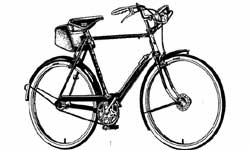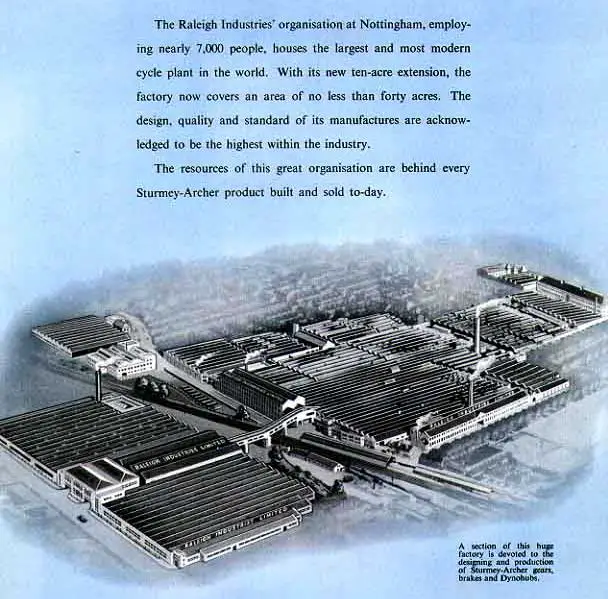Raleigh of Nottingham was for many decades the worlds leading manufacturer of bicycles. Here are some of the high points of a more than a century of bicycle manufacture.
| 1886 | Three Englishmen - Woodhead, Angois and Ellis - begin building bicycles in a small workshop on Raleigh Street, Nottingham. |
| 1887 | Alfred Milward Reynolds invents the process of butting (of tubes). |
| 1888 | Frank Bowden purchases the Woodhead/Angois/Ellis bicycle workshop on Raleigh Street and renames it the Raleigh Cycle Company. At this point there are about a dozen employees and production is three high-wheelers a week. |
| 1889 | Reynolds founds the Patented Butted Tube Company. |
| 1895 | British stockbroker Terah Hooley buys controlling interest in Raleigh. |
| 1896 | Fred Hanstock builds the first Carlton bicycles in Carlton, England. |
| 1896 | Raleigh has the world's largest bicycle factory, occupying 7 1/2 acres. There are about 850 employees and production is 30,000 units per year. |
| 1902 | Raleigh buys Sturmey-Archer. |
| 1923 | Patented Butted Tube Company name is changed to Reynolds Tube Company, Ltd. |
| 1930's | Carlton bicycle factory moves to larger facilities in Worksop, England. |
| 1932 | Raleigh buys Humber Cycles. |
| 1935 | Reynolds 531 manganese-molybdenum ("mang-moly") tubing is developed. |
| 1938 | Raleighs first exported to Canada. |
| 1943 | Raleigh buys Rudge-Whitworth. |
| 1953 | Raleigh buys the Triumph Cycle Company. |
| 1957 | Raleigh buys BSA (Birmingham Small Arms). |
| 1960 | Raleigh and the Tube Investments Group (aka TI) merge, forming TI Raleigh. |
| 1960 | Raleigh purchases the Carlton bicycle factory in Worksop. Production of all handbuilt, Reynolds 531 frames are moved to Worksop. |
| 1972 | Raleigh opens factory in Waterloo, Quebec, Canada. |
| 1974 | TI Raleigh completes its Ilkeston factory. Specialty bicycle section (handbuilt one-of-a-kind frames) is moved from Worksop to Ilkeston. |
| 1975 | Reynolds 753 tubing is introduced. |
| 1977 | Reynolds Tube Company, Ltd. name is changed to TI Reynolds to reflect the growing diversity of the company's products. |
| 1979 | Production of Raleigh 531DB-tubed bicycles reaches 10,000 units a year. |
| 1982 | Rights to the Raleigh U.S.A. name are bought by the Huffy Corporation. Better models from the Huffy era were made in Japan.
No more British-made Raleighs will be imported to the U.S. from this time forward. |
| 1984 | Aboard Raleigh-badged bicycles, Team U.S.A. scores impressive victories at the Olympic Games. This marks the introduction of "funny" bikes. |
| 1986 | Huffy deal expires, Raleigh USA division of Tube Investments. |
| 1987 | Derby International Corporation, a multinational conglomerate, buys Raleigh from Tube Investments. |
The Nottingham Works in 1952, from the 50th anniversary Sturmey-Archer booklet.
This factory was torn down in 2002.
![]()


